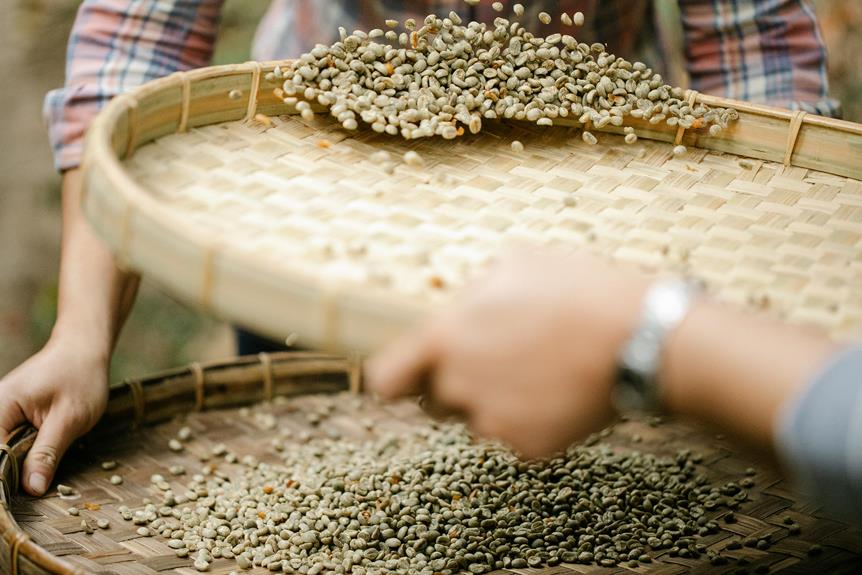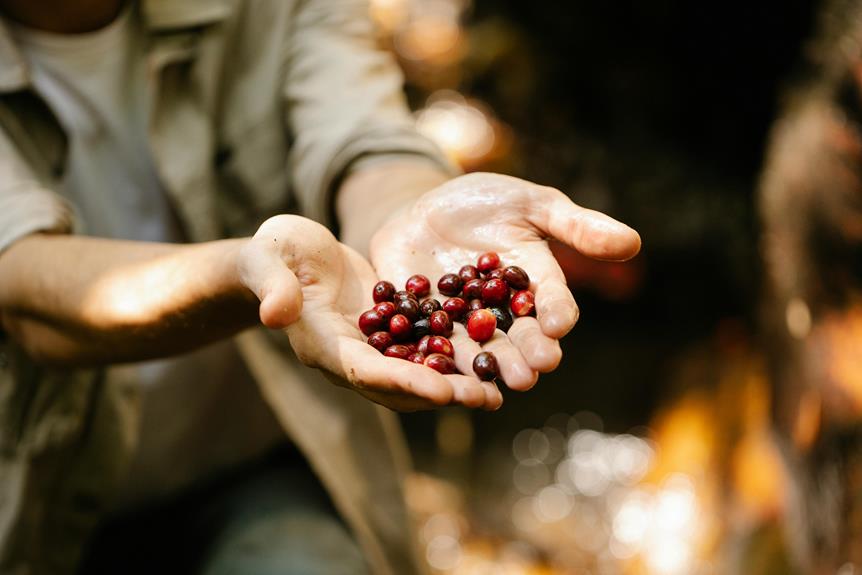You're about to tap into the full flavor potential of your French press coffee by mastering the key variables that make all the difference. Start by selecting high-quality coffee beans that suit your taste preferences, and grind them to a medium-coarse consistency for ideal extraction. Heat your water to the perfect temperature, between 195°F and 205°F, and adjust the coffee-to-water ratio to find your ideal balance. Don't forget to stir and scoop carefully to facilitate even extraction. By fine-tuning these details, you'll be on your way to brewing like a pro – and there's even more to discover to take your French press coffee to the next level.
Key Takeaways
- Select high-quality coffee beans that suit your taste preferences and consider the origin and roast level for optimal flavor.
- Use a burr grinder to achieve a medium-coarse grind and perform regular maintenance to prevent buildup and corrosion.
- Heat water to between 195°F and 205°F for optimal flavor extraction, and use a circular motion when pouring to ensure even saturation.
- Experiment with coffee-to-water ratios and steeping times to find the perfect balance for your desired flavor profile.
- Regularly clean and maintain your French press to prevent buildup and old coffee oils from affecting the flavor.
Choosing the Right Coffee Beans
You'll want to select a high-quality coffee bean that suits your taste preferences. When it comes to French press coffee, the type of bean you choose can greatly impact the flavor profile. Consider the bean origin, as it can affect the flavor notes and acidity level. For example, beans from Ethiopia tend to have fruity and floral notes, while those from Brazil have a nuttier flavor.
Next, think about the roast level. Do you prefer a lighter, more acidic roast or a darker, bolder one? Lighter roasts bring out the coffee's natural acidity and fruit notes, while darker roasts have a deeper, richer flavor. If you're new to French press, a medium roast is a good starting point. It offers a balanced flavor with notes of chocolate and nuts.
Ultimately, the right coffee bean for you'll depend on your personal taste preferences. Experiment with different origins and roast levels to find the perfect combination. By choosing a high-quality coffee bean that suits your taste, you'll be well on your way to brewing exceptional French press coffee.
Grinding for Optimal Extraction
With your coffee beans selected, it's time to grind them to the perfect consistency for ideal extraction.
You'll want to aim for a medium-coarse grind, as this will allow for the right balance of flavor and body in your French press coffee.
To achieve this, you'll need to use a burr grinder, as blade grinders can generate heat and damage your beans.
Make sure to perform regular burr maintenance to prevent any buildup or corrosion that could affect the grind.
Before grinding, calibrate your grinder to certify it's producing the right consistency.
You can do this by grinding a small batch and checking the particles' size and uniformity.
Adjust the grinder as needed until you get the desired result.
Remember, the key to peak extraction is a consistent grind, so take your time and get it right.
With your beans ground to perfection, you're one step closer to brewing a delicious French press coffee that will impress even the most discerning palates.
Water Temperature Matters
Heat water to between 195°F and 205°F to release the full flavor potential of your French press coffee.
This temperature range is vital, as it allows for the perfect extraction of flavors and oils from the coffee grounds. If the water is too hot, it can cause thermal shock, which can lead to a bitter taste. On the other hand, water that's too cold won't extract enough flavors, resulting in a weak or underwhelming cup.
It's also important to note that boiling water isn't ideal for French press coffee.
When water reaches its boiling point, it can become too hot, leading to a burnt or over-extracted taste. By heating the water to the recommended temperature range, you'll be able to achieve a smooth, rich flavor that brings out the best in your coffee beans.
Perfecting the Coffee-to-Water Ratio
Now that you've got the ideal water temperature, it's time to focus on the perfect coffee-to-water ratio, which can make or break the flavor of your French press coffee.
The ratio of coffee to water is essential, as it affects the extraction of flavors and oils from the coffee beans. A general rule of thumb is to use 1 tablespoon of coffee for every 6 ounces of water. However, this is just a starting point, and you'll need to experiment to find your perfect ratio.
Ratio experimentation is key to mastering the French press. Try adjusting the ratio to suit your taste preferences. If you prefer a stronger coffee, use more coffee and less water. If you prefer a lighter flavor, use less coffee and more water.
Water dynamics also play a role in the ratio. The way the water flows through the coffee grounds affects the extraction, so make sure to pour the water in a circular motion to evenly saturate all the grounds.
The Importance of Steeping Time
As you've dialed in your coffee-to-water ratio, you're ready to tackle the next essential aspect of French press brewing: the steeping time, which can make all the difference between a mediocre and an exceptional cup.
This is where Steeping Science comes into play. The longer you steep, the more oils and solids are extracted from the coffee grounds, resulting in a bolder flavor. However, over-steeping can lead to bitterness and a murky texture.
To master the steeping time, it's essential to practice Time Management. Aim for a steeping time between 3-5 minutes, depending on your desired flavor profile.
If you prefer a lighter taste, steep for 3-3.5 minutes. For a richer flavor, steep for 4-5 minutes. Remember, the key is to find the sweet spot that works for you.
Don't be afraid to experiment and adjust the steeping time based on your personal taste preferences. With practice, you'll develop a keen sense of timing, and your French press brews will become consistently exceptional.
Stirring and Scooping Techniques
While the coffee steeps, take a moment to stir the mixture to guarantee all grounds are saturated, then scoop out any stray particles that rise to the surface. This vital step prevents a balanced flavor and prevents any bitter notes from dominating your brew.
When stirring, use a gentle spiral motion with your ceramic spoon to distribute the coffee grounds evenly. Be careful not to stir too vigorously, as this can lead to over-extraction.
Even extraction: Your coffee will taste more balanced and nuanced.
Reduced bitterness: By removing stray particles, you'll minimize the risk of bitter notes.
Improved flavor: Your coffee will have a more refined and complex flavor profile.
Increased enjoyment: With a better-tasting coffee, you'll look forward to every sip!
Avoiding Common Brewing Mistakes
You've perfectly extracted your coffee, but even with proper stirring and scooping, mistakes can still occur during the brewing process that can ruin your perfect cup.
One common mistake is Coffee Shock, which happens when you add hot water to cold coffee grounds. This temperature shock can result in a bitter taste and an unbalanced flavor. To avoid Coffee Shock, make sure your coffee grounds and water are at a similar temperature before brewing.
Another mistake is Freshness Failure, which occurs when you use stale or old coffee beans. Fresh coffee beans are essential for a perfect cup, so try to use beans within a week or two of opening. If you notice your coffee tasting dull or stale, it might be time to refresh your coffee supply.
Additionally, be mindful of your coffee-to-water ratio. If it's off, your coffee can taste weak or overpowering. Experiment with different ratios to find your perfect balance.
Cleaning and Maintenance Essentials
Regularly cleaning your French press is essential to preventing old coffee oils and residue from ruining your brew's flavor and aroma.
Wash it daily: Rinse your French press with warm soapy water after every use to prevent any buildup.
Descaling regularly is also important. Use descaling methods like vinegar and water or a descaling solution to remove mineral deposits that can affect the taste of your coffee.
Replace the filter every 3-6 months to prevent it from becoming clogged and affecting the flow of coffee.
Deep clean your French press monthly by taking it apart and soaking the parts in hot soapy water to remove any stubborn residue.
Experimenting With Flavor Profiles
Now that your French press is clean and in top condition, it's time to get creative and explore the world of flavors with your coffee. You're no longer limited to a single flavor profile; it's time to experiment and find your perfect cup.
One technique to try is flavor layering. This involves adding different ingredients to your coffee at various stages of the brewing process. For example, you could add a cinnamon stick to your grounds before brewing, then add a splash of vanilla extract after pressing. This creates a complex flavor profile that's unique to your taste.
Another approach is spice infusions. Try adding a pinch of ground ginger or cardamom to your grounds before brewing for a warm, spicy flavor. You could also experiment with citrus zest or cocoa powder for a brighter, more decadent taste. Remember, the key to success is experimentation. Don't be afraid to try new combinations and adjust to your taste.
With a little practice, you'll be crafting flavor profiles like a pro and enjoying a truly unique cup every time.
Frequently Asked Questions
Can I Use a French Press to Make Tea or Other Infused Beverages?
You can definitely use a French press to make tea or other infused beverages, and it's perfect for exploring different tea varieties and infusion times to find your ideal cup, whether it's a strong black or delicate green tea.
How Do I Store My French Press Coffee Maker When Not in Use?
Don't you wish you had a dedicated spot for your French press? When not in use, you'll want to store it in a dry Coffee Cabinet to guarantee dust protection, keeping it clean and ready for its next brew.
Is It Safe to Put My French Press in the Dishwasher?
You're wondering if it's safe to toss your French press in the dishwasher. Generally, it's not recommended, as high heat and harsh detergents can damage the material. Instead, opt for gentle hand washing and drying to maintain Dishwasher Safety.
Can I Use a French Press to Make Cold Brew Coffee?
Like a phoenix rising from the ashes, your coffee game is about to level up! You can definitely use a French press to make cold brew coffee, but be mindful of brew strength and grind size to avoid a bitter taste.
How Often Should I Replace the French Press's Metal or Nylon Filter?
You'll want to replace your French press's metal or nylon filter every 3-6 months, depending on usage, to maintain peak filter performance and prevent clogs, as screen durability decreases over time with regular cleaning and use.
Conclusion
You've mastered the French press! Now, the world of rich, bold flavors is at your fingertips.
Like a conductor leading an orchestra, you've harmonized the perfect blend of beans, grind, temperature, ratio, and steeping time.
Don't get complacent, though – the French press is a dynamic dance, and experimentation is key to revealing new flavors.
So, keep pushing the boundaries, and your taste buds will sing in perfect harmony.









